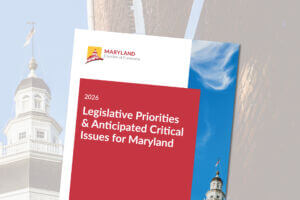Blog
Policy Primer: Maryland’s Paid Family & Medical Leave Insurance Program
May 31, 2023
In 2022, the Maryland General Assembly passed the Family and Medical Leave Insurance Program, otherwise known as the Time to Care Act, which made Maryland the 11th state, including Washington, D.C., to adopt a statewide family and medical leave program. During the 2023 legislative session, the General Assembly passed the modifications bill (SB828/HB988), which the Governor signed into law on May 3, 2023. This legislation made significant changes to the program. Under the program, eligible employees will be entitled to receive up to 12 weeks of paid family and medical leave per benefit year.
The Maryland Department of Labor is required to issue regulations implementing the program by January 1, 2024. The Department will begin the regulatory drafting process and stakeholder involvement in June 2023.
Implementation
Contributions to the program will begin on October 1, 2024. This means that by this date, employers and employees will begin seeing their portion of the cost removed from their funds and paychecks to build up the state’s pot of funding before the program begins awarding benefits. Employees can submit claims for benefits starting on January 1, 2026. The Maryland Department of Labor (“the Department”) is required to issue regulations implementing the program by January 1, 2024.
Cost Sharing and Total Rate of Contribution
The contribution rate is a 50/50 split between employers and employees. Maryland’s Secretary of Labor is required to set the total rate of contribution for employers and employees by October 1, 2023. This rate will be in effect beginning on October 1, 2024 through June 30, 2026. The total contribution rate cannot exceed 1.2% of an employee’s wages up to the Social Security wage base.
Eligibility
Beginning October 1, 2024, every employee working in Maryland and employers with 15 or more employees must begin contributing to the program’s fund. Self-employed individuals are not required to contribute. They may choose to opt-in to the program. A covered employee is defined as one who has worked at least 680 hours over a 12-month period immediately preceding the date on which leave is to begin. This includes full-time, part-time, private sector and government employees. However, this does not include federal government employees. The 680 hours could be made up of multiple jobs worked (in Maryland) over the 12-month period. Regarding if benefits apply to those who work remotely out-of-state for a Maryland employer, or those who work remotely in Maryland for an out-of-state employer, the Department will need to address that in their regulations.
Covered employers include any person or governmental authority that employs at least one individual in the state of Maryland.
Benefit Amount
The weekly benefit amount must be at least $50 and may not exceed $1,000 for the 12-month period beginning January 1, 2026. The maximum benefit amount increases based on Consumer Price Index (CPI), however the benefit amount for each individual is not based on CPI. Only employees at the maximum benefit amount will see a change.
Application and Notification Periods
Employees have up to 60 days before the anticipated start date of leave and no later than 60 days after the start date of leave to file an application for benefits.
Foreseen leave — An employer may require an employee to provide the employer with written notice of their intention to take leave at least 30 days before starting the leave.
Unforeseen leave — The employee shall provide notice to the employer as soon as practicable.
Concurrency
Employers cannot require that their employees use or exhaust paid vacation, paid sick leave, or other paid time off under an employer policy before or while receiving FAMLI benefits. The employer and employee, however, can agree that the employee will use available paid vacation, sick leave or other time off to receive up to 100% of the individual’s average weekly wage during their FAMLI leave period.
It’s important to note that the above does not apply to separate employer-provided leave policy due to parental care, family care, or military leave or under a disability policy. For these employer-provided benefits, the statute states that an employer can require FAMLI benefit payments to be made concurrently with or otherwise be coordinated with payments made or leave allowed under the employer policy.
Qualifying Reasons to Apply for Benefits
- To care for a child during the first year after the child’s birth or before or during the first year after the placement of the child through foster care, kinship care or adoption
- To care for a family member with a serious health condition
- The employee’s own serious health condition that results in their being unable to perform the functions of their position
- To care for a service member who is the employee’s next of kin
- For a qualifying exigency arising out of the deployment of a service member who is a family member of the employee


